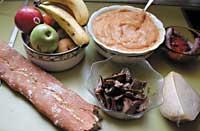Interaction between food and medicines

In general, if the medicine is taken with food and drinks, the absorption of the drug slows down, so it is much harder to get the concentration needed to heal in blood. For example, if L-dopa and penicillin drugs are taken when the stomach is full, they become inactive by hydrochloric acid in the stomach. Other medications are more easily absorbed if the stomach is full, such as nitrofurantoin or hydralacine.
Effects of each drug
Nutrients that may exist in the digestive system influence the absorption of the drug; for example, if antimicrobial tetracycline binds to calcium, a non-absorbable structure is formed. Tetracycline should therefore not be taken along with milk, dairy products, or calcium-containing supplements. Something similar happens with tetracycline, penicillamine, methylope and thyroxine and iron, so they should not be taken at once.
When taking antibiotics it is very important to take care of the intestine. The antibiotic acts on all intestinal bacteria, beneficial and harmful, eliminating all. To recover favorable bacteria as soon as possible, it is of great help to take food with bifidobacteria.

Other drugs act on the intestinal membrane, affecting the absorption of many nutrients. These include laxatives and anti-inflammatory drugs. On the other hand, laxatives accelerate intestinal movement and nutrients spend less time in the intestine, making it difficult to absorb them. This mainly affects vitamins A and D and calcium and phosphorus minerals.
On the other hand, there are medicines that help eliminate nutrients and, if consumed for a long time, there is a risk that there will be a lack of these nutrients. For example, if taken often, aspirin can cause deficiencies in vitamin C, potassium, and iron. To prevent deficiency, those who consume a lot of aspirin should take fruits and vegetables rich in vitamin C and potassium.
Corticosteroids also influence fluid and electrolyte balance and vitamin D level. Therefore, it is advisable to take foods with vitamin D. Long-term treatments should also pay attention to calcium, as vitamin D is needed to absorb calcium.
Diuretics also make it difficult to absorb calcium in the kidney. They also contribute to the elimination of potassium, sodium, magnesium and zinc minerals, with the risk that their prolonged consumption causes deficiencies.

Antacids reduce the absorption of folic acid and iron, as well as medications that lower blood cholesterol levels. These also make it difficult to absorb vitamins A, D, K and B12.
They also influence metabolism
The effect of drugs is not only detected in absorption, but sometimes influences the metabolism of nutrients. For example, some drugs used to cure artitrise affect the metabolism of folic acid. The medicine used to cure tuberculosis, isocyanide, binds to vitamin B6 and can cause its deficiency. In both cases, it is advisable to take more food with these vitamins in foods that we do not take. Folic acid is mainly found in green vegetables, fruit and nuts, and vitamin B6 mainly in meat, legumes and avocado.
Other times, your doctor may tell you not to take certain foods with certain medicines. The goal is to increase the effect of the drug. With medicines to prevent blood clotting, for example, you should not take foods rich in vitamin K: relatives of cabbage, parsley, spinach... Vitamin K contributes to blood clotting.
In addition to all this, it should be noted that many medications influence the idea of eating. Antihistamines and cortisone increase the feeling of hunger and methylphenate does the opposite. On the other hand, one of the main risk groups for malnutrition is cancer patients, who often suffer from nausea and vomiting as a result of treatment. These patients are currently being tested using diets composed of low-color foods and odor, which hope to have less nausea and vomiting so as not to worsen the nutritional status of patients.
Buletina
Bidali zure helbide elektronikoa eta jaso asteroko buletina zure sarrera-ontzian











